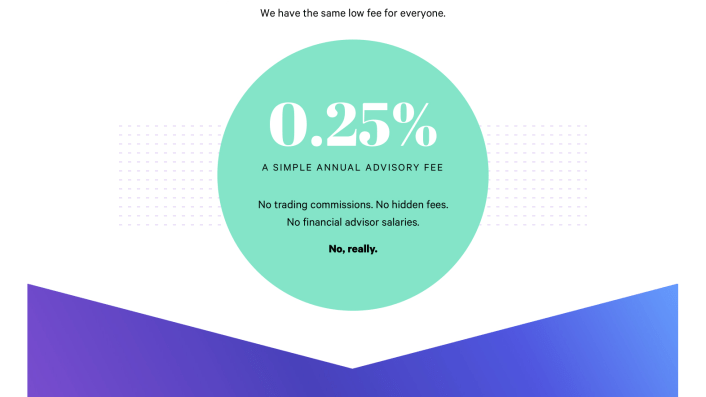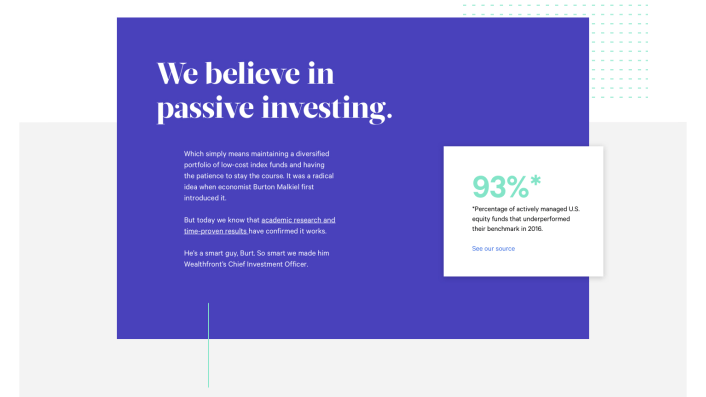How Wealthfront is Trying To Make Its Robo-Advisor Feel More Human
Wealthfront, the only major robo-advisor based in Silicon Valley, takes pride in its origins as an engineer-driven company. Newly wealthy techies at nearby Facebook and LinkedIn, attracted to Wealthfront’s almost monastic product focus, were the company’s first customers.
Even though robo-advising is a consumer-facing financial services business, cofounder and CEO Andy Rachleff stubbornly avoided hiring marketers and “scummy” finance types (“scummy” is his favorite Wall Street adjective). “They just don’t think about doing right by the client,” he says. “And when you’ve been conditioned a particular way, it’s very hard to break that mind-set.”
But as Wealthfront has discovered, Facebook millionaires are not representative of most potential robo customers (though those tech titans are not a bad foundation—the company now boasts 130,000 clients and nearly $6.7 billion in assets under management.) In order to take on rivals like Betterment and Charles Schwab, Wealthfront will have to break out of its Silicon Valley stronghold and develop a new growth engine. Rachleff’s first step toward that goal: Hiring a vice president of marketing, at last.
Twitter and YouTube veteran Josh Grau stepped into the role this past spring, and has been racing ever since to design an overhaul of Wealthfront’s website. The revamped look launched earlier today, showcasing a softly humanized version of the company’s robo story.
“This is serious stuff and we’re taking it seriously, but we want to make people feel like we’re having this conversation in their living room,” Grau says of the user experience the company has attempted to design.

That means aspirational illustrations instead of clip art or stock photos, and a sense of real-life journey throughout the site. On a board pinned with near-final mockups of the website in Wealthfront’s Redwood City offices, there are print-outs of Instagram photos to serve as inspiration to the project’s designers, and a Post-it suggesting that the team add plants and wedding photos to a dinner party image on the site. All of it is geared toward an avatar the company thinks of as the “modern traditionalist,” Grau’s intended target within the millennial demographic.
“They’re thinking about the more traditional things like getting married, buying a home,” he says of this demographic. “But they also think about just living their best life.”
Last month Betterment, the leading independent robo-advisor as measured by assets under management, also updated its look. The company commissioned a photo shoot, including portraits of its team in action, and rewrote much of its explanatory language. If Wealthfront tells a story, Betterment offers a clear window into its own inner workings. Both companies emphasize helping customers work toward personal goals like buying a home and paying for college.

For Wealthfront, the stakes of its new approach are arguably higher. Betterment offers customers a hybrid model, wherein human financial advisors are available, via phone, for an extra fee. Wealthfront, in contrast, is all-in on the robo approach. In times of fear or anxiety—say, if the markets tank—Wealthfront’s interface will have to reassure customers with a finesse equivalent to that of a real, live, breathing human being.
Wealthfront believes that means nailing a more human-like content and tone, and building deeper relationships. For example, Grau envisions his product’s user experience eventually incorporating more features that celebrate user milestones, like saving enough for a down payment, and reward hard work and sacrifice on the part of the customer, such as increasing a monthly auto deposit.

Active investing is like “tornado chasing,” Grau adds. But passive investing should feel like a picnic in the park—just like the picnic now featured on Wealthfront’s home page.
Engineer-driven Wealthfront is putting more emphasis on its marketing, starting with a new site that ditches financial jargon for something more personable.
Wealthfront, the only major robo-advisor based in Silicon Valley, takes pride in its origins as an engineer-driven company. Newly wealthy techies at nearby Facebook and LinkedIn, attracted to Wealthfront’s almost monastic product focus, were the company’s first customers.











Fast Company , Read Full Story
(38)













